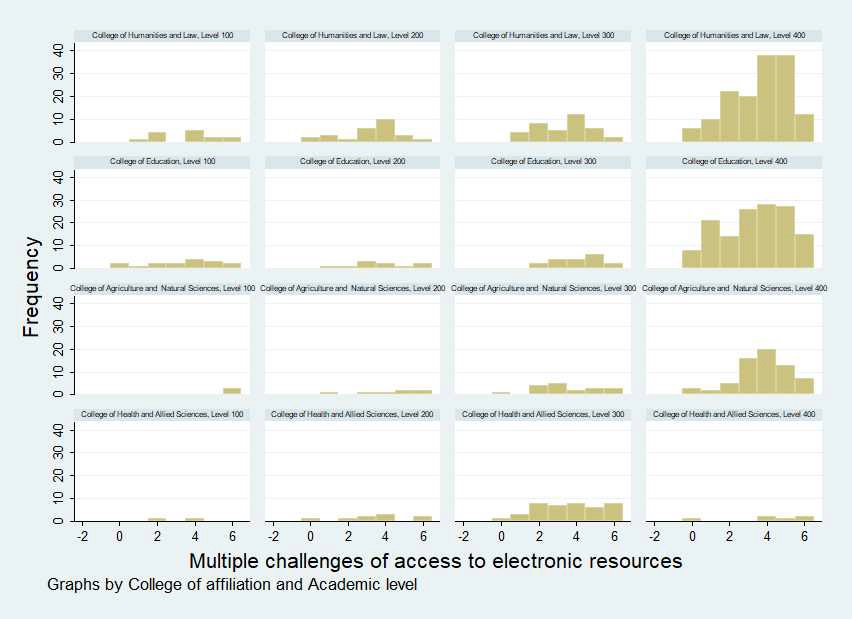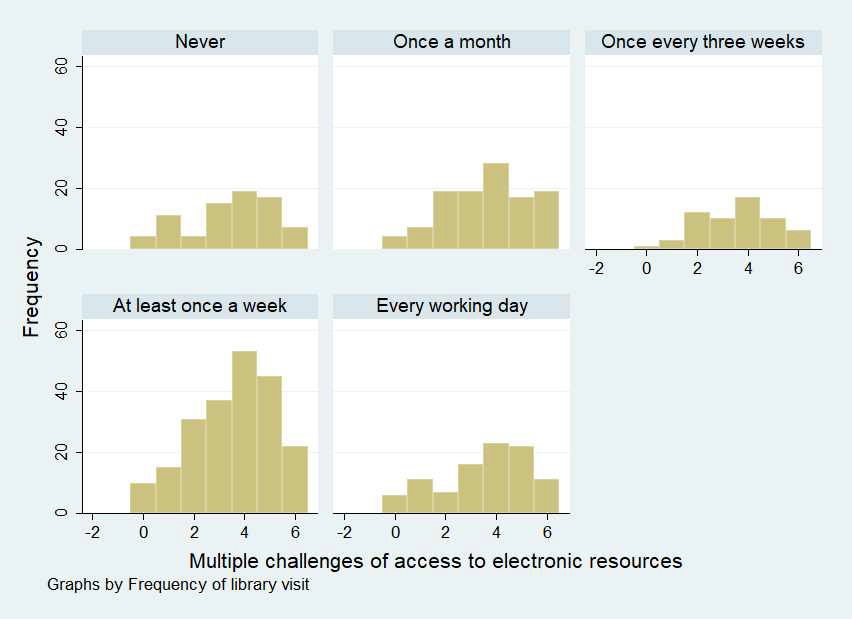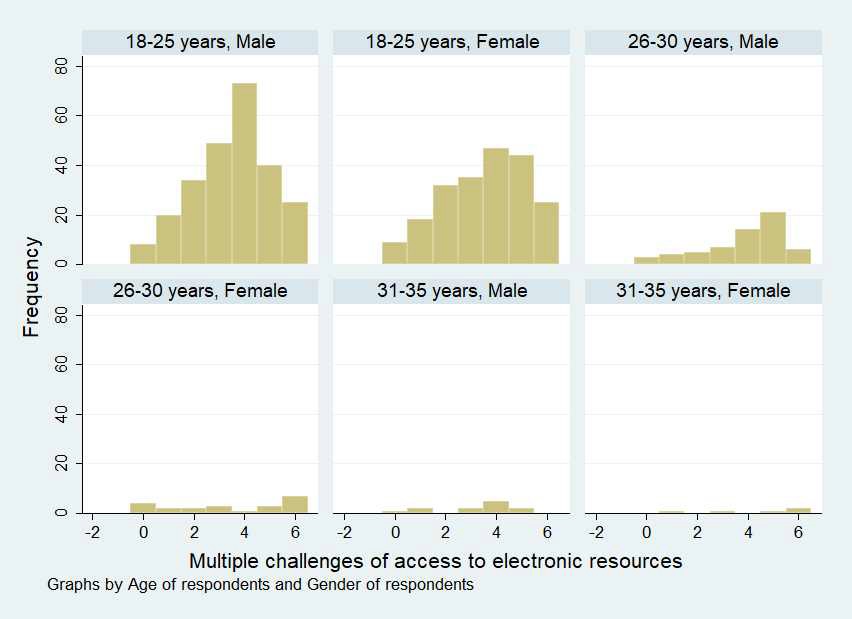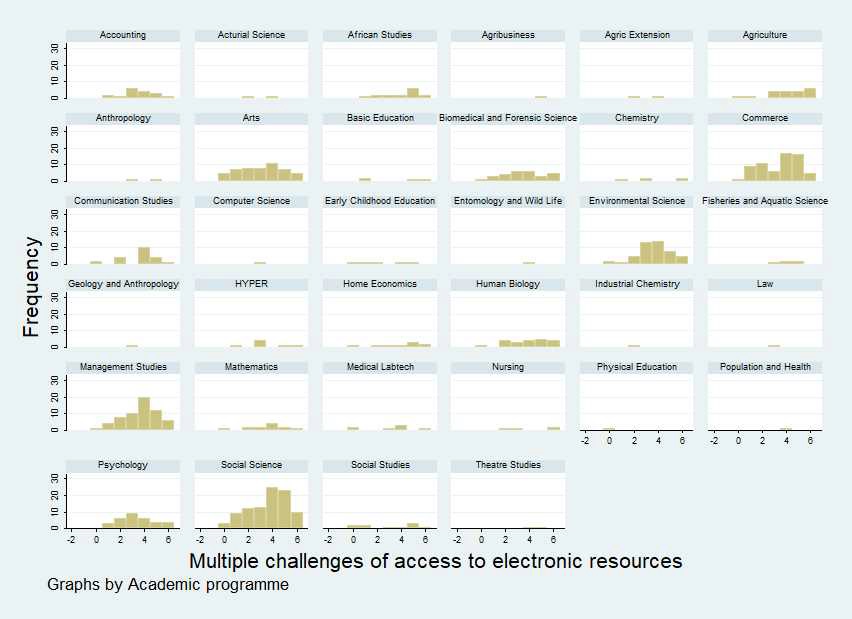



Technological advancements have made the internet and the World Wide Web the most useful means of communicating and harnessing information. This attribute has brought about the hybridization of most academic libraries across the globe, with increasing emphasis on access to electronic information resources. According to Adeniran (2013) electronic resource is one of the emerging competitive components in libraries and information communication due to their ease of access and ability to be accessed around the clock. Library collections of print resources or formats are in sharp decline and the use of electronic journals (e-journals), electronic books (e-books) and databases are apparently in vogue to aid the academic work of students and researchers. Availability and timely access to these wealth of e-resources are pertinent to patrons as they constantly rely on research work for scholarship. E-resources usually consist of e-books, e-journals, and other electronic materials such as articles, theses, dissertations, databases and CD-ROMs, which are likely to be the alternative to the print media (Gakibayo & Okello-Obura, 2013). The success of academic libraries depends on the ability of users to get fast track information sources to better serve the needs of the academic community. Technological savvy users in this digital era are highly impatient and time conscious when searching for information―they want information “Just now or Never” (Chandel & Saika, 2012).
Libraries in third world countries have challenges subscribing to e-resources due to financial constraints. In Ghana as in other countries in sub-Saharan Africa, university libraries are still making substantial effort to provide access to useful electronic information resources to support teaching, research and learning in the face of financial constraints associated with the provision of both print and electronic resources to its users (Dadzie, 2005; Ndungu, 2016). According to Kwafoa, Imoro, and Afful-Arthur (2016), owing to the great importance and usefulness of electronic resources, the Consortium of Academic and Research libraries Ghana (CARLIGH) pays on average of $ 250,000 as subscription fees to enable students, faculty and researchers affiliated to the Consortium have unlimited access to selected scholarly electronic resources but surprisingly this expensive venture is underutilized by users. Some studies in Ghana and Nigeria (see Quadri, Adetimirin, & Idowu, 2014; Borteye & Dadzie, 2015; Kwadzo, 2015; Akuffo & Budu, 2019) have explored the availability, use and access of electronic resources by students, however; there is a gap between availability and accessibility of e-resources for which reason there is the need to examine in closer detail how and why the patronage is low. This could be due to an interplay of several unique factors both compositional (user demographic attributes, skillset, prior experiences, generational) and contextual (institution-specific factors such as the college of affiliation, the library environment). Previous studies have almost exclusively focused on independent challenges with little attention to concurrent or simultaneous multiple challenges. Based on the foregoing, this study evaluated the nature of multiple challenges confronting undergraduate students in their bid to access electronic resources, using the Sam Jonah Library of the University of Cape Coast, Ghana as a case study.
1.1 The Objective of the Study
The main goal of this study is to examine the nature and extent of multiple challenges confronted by undergraduates’ students in accessing electronic information resources at the Sam Jonah Library, University of Cape Coast, based on user’s varying compositional and contextual characteristics. These students are from the four constituent colleges of the University of Cape Coast.
This study is significant because it contributes to a deeper understanding of how demographic characteristics and institutional context jointly mediates (enable/constrain) access to electronic resources in academic libraries. The emphasis on simultaneous multiple challenges is necessary to elicit information on the most challenged sub-group and thereby target them for solutions. A sub-group (e.g., final year undergraduate) that faces 5 access-related challenges may not require the same attention as a sub-group (e.g., first-year undergraduate) who faces only one access-related challenge. When users of academic libraries access electronic resources they have in mind materials that are findable, credible, desirable, accessible, useful, usable, and valuable (Zhang & Niu, 2016). These attributes define the experiences of the user. More importantly, each of these attributes is linked in one way or another to the institutional context of the academic library user.
Electronic information resources help in facilitating access to information we need in an easy and speedy manner and this has become the backbone of many academic institutions of higher learning (Oduwole & Akpati, 2003; Ukachi, 2015). Electronic resources have proved to be invaluable to many academic institutions around the globe due to the changing needs of patrons and information communication and technology tools. According to Adeleke and Nwalo (2017) library users are aware that libraries comprise electronic resources that are more comprehensive, scholarly and relevant to their needs than most websites provide. In the light of literature, many studies have delved into this theme of usage of electronic resources by both graduates and undergraduates. Tripathi and Jeevan (2013) reviewed published literature on the importance of the usage of electronic resources in academic libraries, and found that students were the biggest users of online resources in terms of sessions undertaken and pages viewed. They recommended that the usage of e-resources should be regularly examined and users’ attitude, behaviour and their modes of searching could be properly reviewed so that the library can effectively serve it to users around the world. Other studies (see Natarajan et al., 2010; Adeniran, 2013; Omosekejimi, Eghworo, & Ogo, 2015) listed similar challenges including lack of awareness, and insufficient time as factors that hinder access and use of electronic resources.
Shija (2009) used secondary survey data to research into the main causes of low patronage of electronic resources among students, and observed that lack of enough internet skills and awareness, poor infrastructure and connectivity as well as non-use of single sign in on systems were dominant challenges. Quadri, Adetimirin, and Idowu (2014), Omeluzor, Akibu, and Akinwoye (2016), Ojo and Akande (2005) suggest that most students use the e-resources for assignments and research projects however access to relevant e-resources vary especially across the various disciplines in Nigeria. According to Ameyaw, Kwakye, and Asante (2016), erratic power supply coupled with erratic internet connectivity and lack of skills for exploiting resources by undergraduate students are some of the major challenges faced by students in public universities in Ghana. Manda and Mukangara (2007) examined the association between gender and the use of electronic information resources in the area of training, access, awareness and availability and year of study, and concluded that males were more likely to use electronic information resources than female students in a public university in Tanzania.
Ameyaw, Kwakye, and Asante (2016) investigated the challenges users face when accessing electronic resources in the library and identified unreliable power supply and snail speed of internet connectivity as a major challenge. This is similar to what Akporhonor and Akpojotor (2016) found in the context of Library and Information Science postgraduate students in Nigeria where access to electronic resources was characterized by poor connectivity coupled with epileptic power supply, high cost of access, and download delays. Ternenge and Kashimana (2019) in their research study on availability, accessibility and use of electronic information in Nigeria exposed power outages, slow and poor internet connectivity, lack of relevant resources as challenges obstructing students from use.
Dadzie (2005) explored access and use of electronic resources in Ashesi University College, Ghana, and found that the overall computer usage for information access was high because the University had the infrastructure in place but the use of some databases was low due to inadequate information or awareness about the existence of these, library resources and lack of personal computers in the library. Sundry factors have been attributed to low patronage including lack of awareness of such a facility, poor ICT infrastructure and lack of knowledge on how to use e-journals (see Igbo & Imo, 2017; Omeluzor, 2016; Akussah, Asante, & Adu-Sarkodee, 2015; Obeng-Koranteng & Dzandu, 2013); low internet bandwidth coupled with high cost of internet and frequent power cuts (see Omeluzor et al., 2012) and slow downloading and blockage of websites (Sohail & Ahmad, 2017).
Cobblah (2014), in his study assessed CARLIGH electronic resource provision to member institutions and identified five favourable evaluative parameters under which e-resources are being used. Thus, the availability of internet connectivity in libraries, users’ competence in information literacy, awareness of e-resource provision, user satisfaction with coverage and impact of e-resources to teaching, learning and research. That study revealed that 82.4% of faculty, students and librarians are aware of e-resources provision, 80% of respondents were satisfied with the subject coverage of the e-resources and 98.4% of member libraries have the basic facility in place for users to access these electronic information resources. Tetteh (2018) researched into usage evaluation of electronic resources in academic and research libraries in Ghana. Using usage statistics to access the level of usage, to ascertain cost peruse and to identify periods of high and low patronage, her study brought to light e-information resources usage has increased but it is not consistent over the years (2010-2015), rather the cost per use of an article in selected databases have not reduced but rather increased from $0.60 in 2012 to $4.06 in 2013, then to $5.08 in 2014 and to $5.26 in 2015. Hence, the cost of purchasing or subscribing to these electronic information services is not going to dwindle but will keep on soaring. Academic institutions must make sure users do not have any challenges in accessing these costly information resources.
Notwithstanding the fact that the foregoing studies have independently identified sundry challenges they failed to assess the propensity to experience challenges simultaneously, and which demographic subgroups were more predisposed to reporting a higher number of challenges. This brings into sharp focus the importance of this study.
A descriptive survey research design was used in this study. The choice of this design was tied to the objectives of the study. Surveys are designed to provide a ‘Snapshot of How Things are at a specific Time’. Surveys allow researchers to reach thousands of possible participants if necessary, which ensures a more accurate sample from which to draw conclusions. The anonymity of surveys allows people to feel more candid with their responses as there is no manipulation of variables or preferential treatment with respondents. Data used for this study were collected using a questionnaire.
The random sample was drawn from a population of full time undergraduate students at the University of Cape Coast who are users of the Sam Jonah Library (Main University Library). Sample were taken from students of four out of the five colleges namely the College of Health and Allied Sciences (CoHAS) with 2,846 students, College of Agriculture and Natural Sciences (CANS) with 3,523 students, College of Humanities and Legal Studies (CHLS) with 7,108 students enrollment and College of Education Studies (CES) with 5,017 students during the second semester of the 2018/2019 academic year. Students from the fifth college, the College of Distance Education (CoDE) were not considered in this study because they are not regular full-time undergraduate students. Out of the total population of 18,494 undergraduate students, six hundred and fifty (650) respondents were contacted out of which six hundred agreed (600) to participate in the survey. Of the lot who received the survey instrument, 558 individuals returned copies of the questionnaire. This represents a response of rate of 93% consisting of 321 male and 237 female undergraduate students. No data that personally identified individuals in the study samples were stored.
Copies of the questionnaire were distributed with the help of the academic staff to the students at the selected classes and were given 20-30 minutes to answer the questions. The academic staff instructed the students to return the completed questionnaires at the reception desks designated at the respective faculties. This method of self-administered questionnaire yielded a higher response rate among the students as a sample (93%). Each questionnaire was divided into four sections: socio-demographic profile of electronic resource users (6 items), nature and scope of use of electronic resources (7 items), barriers/enablers of electronic resource use (13 items) and importance of electronic resources (14 items). The instrument was pilot tested on 20 participants who were not members of the university community and items were refined based on feedback from the respondents.
Data were processed using Statistical Software SPSS IBM (v.21). Descriptive Statistics was used to depict the demographic characteristics of survey participants. The statistical analyses of the data were carried out on all variables in the original datasets and are represented in the histogram. Responses on each challenge were dichotomous (Yes, No) coded as 1 or 0. Multiple challenges were generated from adding each of the responses. This yielded a minimum score of 0 representing users who did not encounter any challenge and a maximum score of 6 representing users who encountered all six challenges. This approach addresses gradations in the challenges users of e-resources encounter in order to identify the most vulnerable sub-groups that require distinctive attention. The results were presented as percentages, mean, frequencies in histograms and bar graphs.
Academic libraries strive to provide timely access to relevant electronic information resources to sundry users in the era where emerging technologies promise to revolutionise user experiences. This is seen through a host of related services and facilities packaged to provide trustworthy, convenient and unlimited access to scholarly information resources. In developing countries, the assumption that the availability of electronic information resources necessarily translates to the accessibility of same breaks down completely.
The presentation and discussion of the findings of this study are grouped under four themes based on the objectives of the study. These include the background of respondents, hindrances encountered by undergraduate students in accessing electronic information resources, level of usage of electronic resources by undergraduate students in the colleges and practices to alleviate these challenges to promote easy access and use of electronic resources.
Students identified six key challenges associated with access to electronic resources at the University of Cape Coast library. Table 1 focused exclusively on the demographic distribution of challenges of internet connectivity, information download and portal inaccessibility. The distribution of challenges of internet connectivity, information download and portal inaccessibility were not significantly associated with age, gender, college of affiliation and academic level of undergraduate students (chi-square, p>0.05). This implies that challenges in accessing e-resources did not systematically vary with age, gender, college of affiliation and academic level of undergraduate students.
Distribution of challenges of internet connectivity, information download and portal inaccessibility (n=558)
In Table 2, the distribution of challenges of inadequate computers, poor lighting (ergonomics), ancillary services (printers) did not significantly differ with age, gender, college of affiliation and academic level of undergraduate students (chi-square, p>0.05) indicating no systematic variations based on these characteristics.
Challenges of inadequate computers, poor lighting (ergonomics), ancillary services (printers) (n=558)
Fig. 1 shows the distribution of challenges users faced in accessing e-resources disaggregated by academic level and college of affiliation. It is obvious that more undergraduate students in the third and final year reported a higher number of challenges compared with their counterparts in the first and second years.
Third and final year undergraduate students have spent more time on the university campus than their counterparts in the first and second years. This has likely given them more time and opportunity to identify and characterize these challenges. It is expected that such students would have experienced higher frequency and magnitude of the challenges related to access to e-resources in the past.
Multiple challenges associated with access to e-resources varies systematically based on how frequent the user visits the Library as shown in Fig. 2 Students have access to e-resources on campus outside the library and individuals who never visit the library (Fig. 2) belong to the sub-group who prefer off-site access. It is interesting that this sub-group also had challenges although not to the same extent as their counterparts who patronized the library.
Overall, this indicates that challenges to access to e-resources is not confined to the library building, and by extension, widespread on campus. This is due to different factors, though the major amongst them is awareness creation and the means to access the institutions electronic information resources both on and off-campus. This is in consonance with Igbo and Imo (2017) study on electronic information sharing among university libraries in Nigeria, attributed low patronage and access to electronic resources to lack of awareness and knowledge of usage of such a facility.
Fig. 3 shows challenges to access to e-resources disaggregated by age and gender of the users. An interesting picture emerges with male and female users between 18-25 years disproportionately represented in users with more challenges. Male and female users between 31-35 years barely reported any challenges.
It is intuitive to suggest that older users have garnered considerable experience over time which helps them to surmount or navigate challenges to access e-resources. However, when this is viewed against the background that students at higher academic levels (third and final year) reported more challenges, the picture becomes complex and nuanced. Understanding these nuances is critical to addressing the needs of e-resources users in a manner that is not counter-productive. This might be that older users do not have enough skills and access to computers to access electronic information on a routine basis. This is consistent with Tripathi and Jeevan (2013) study which brought to light the greatest direct factors underlying students’ challenges with the use of online information include lack of browsing skills, low internet bandwidth and insufficient ICT infrastructure, whereas the indirect factors include lack of internet access at home to keep pace with searching skills. Ameyaw, Kwakye, and Asante (2016) study exposed a lack of skills for manipulating resources by undergraduate students are some of the major challenges faced by students in public universities in Ghana. This is in consonance with the findings of Adeleke and Emearaha (2017), opined that easy access to technology, means students spending a substantial quantity of time on the Internet/online but their study showed lack of search techniques skills by many postgraduate students of the university to access the limitless number of e-resources available to students.
Fig. 4 highlights discipline-specific heterogeneities in challenges to access to e-resources. Users with backgrounds in Agribusiness, Actuarial Science, African Studies, Agricultural Extension, Geology and Anthropology, Computer Science, Entomology, Industrial Chemistry, Law, Population and Health, Physical Education, Nursing, Theatre Studies reported very few challenges unlike their counterparts from Arts, Management Studies, Psychology, Commerce, Environmental Studies and Social Science.
The pattern in Fig. 4 is quite complicated as it is difficult to ascribe the challenges or the lack thereof to discipline-specific core competencies. For instance, computer science students reported more challenges than their counterparts in Theatre Studies or Social Studies. It is unclear whether this is due to the fact that Theatre Studies students are less likely to use e-resources than their Computer Science counterparts or it is due to the fact that Computer Science students tend to report more challenges owing to their low tolerance and impatience for various challenges related to e-resource access. Either way, students need more navigational skills to make optimum use of e-resources available to them. According to Bhukuvhani, Chiparausha, and Zuvalinyenga (2012) students do not only require basic information skills but a knowledge of the discipline and the competence to handle multifaceted information. University will have to intensify the efforts in information literacy curriculum- integration, thus adequate training in the use of electronic resources for undergraduates, marketing and training awareness campaigns at all levels. Information literacy as a mandatory fresher course for fresh students must be ongoing instruction at all levels of study and enough time allocated for subject–related practical’s (Renwick, 2005). These can help surmount some challenges in accessing electronic information resources by students.
Remedies of training patrons and expanding ICT facilities (Gakibayo & Okello-Obu, 2013; Kwafoa, Imoro, and Afful-Arthur, 2016), organizing workshops (Bashorun et al., 2011; Sohail & Ahmad, 2017) were recommended solution by sundry studies to improve the awareness and use of electronic resources. Current studies on e-resources studies undertaken in private (Ameyaw, Kwakye, & Asante, 2016) and public universities surveyed postgraduates (Borteye & Dadzie, 2015; Akporhonor & Kpojotor, 2016; Akuffo & Budu, 2019; Adeleke & Nwalo, 2017), undergraduates (Amankwah, 2014; Adeniran, 2013). Despite the overwhelming advantages of online information resources users still face some challenges with the use of e-resource facility. This phenomenon is observed in other universities across the continent. For instance, Mbarara University Library Uganda showed low usage of e-resources and this is evident from the library statistics, register records and from information obtained verbally as low usage of electronic resources was cited as a challenge to the library management. Another study also revealed low usage although the university library conducts workshops, seminars and communicates to students regularly about the available e-resources, students are not successfully using electronic information resources (Gakibayo & Okello-Obu, 2013; Kwadzo, 2015).
Multiple challenges relating to access to e resources is a defining characteristic of universities in sub-Saharan Africa. These challenges emanate from both compositional (skillset, core competencies of users) and contextual (institutional) factors. In this study, the challenges pertain more to the latter than the former. A critical challenge before academic libraries is to develop access paradigms that support the changing circumstances of higher education and emerging communication technologies. This issue concerns the challenge of building and enhancing access to collections that meet academic needs, with the constraints of a limited budget; and balancing the growth of digital and traditional collections. University libraries must take systematic steps to ensure that availability of e-resources necessarily translates to access to these essential resources in the 21st century. A strategy for developing and improving access to e-resources collection is required at the institutional level. This strategy should account for the needs and challenges of all members of the university community―departments, research scholars, lecturers and students.
Research findings of this study indicate that simultaneous challenges undergraduate students face in their quest to access electronic information are predominantly institutional. Based on this, it is recommended that:



